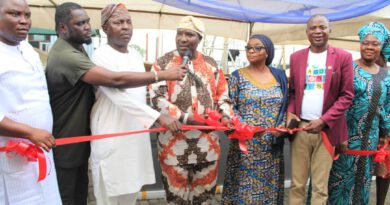LASTMA at 25: Achievements and Pitfalls
On July 15th, 2025, the Lagos State Traffic Management Authority (LASTMA) turned twenty-five years in the service of the state and was humbly celebrated without pageantry and fanfare.
Ideally, the event calls for greater celebration as imagining the state of the Lagos city without LASTMA would have been a disaster. Practically, there would have been no movement of persons and goods. The State would have simply been at a standstill and the economic growth stultified.
Lagos, Nigeria’s commercial nerve centre and capital, is a megacity of over 20 million inhabitants and one of the fastest-growing urban cities in the world.
With its explosive population growth, rapid urbanisation, and concentrated economic activities, traffic congestion has become a defining feature of the city.
In fact, at a point in time, traffic gridlock in the city was a nightmare. But for the reality that the city is inevitable to be patronized by a lot of Nigerians and even traders from other West African countries, it would have been avoided. The commercial necessity and the opportunities inherent in the city thus compel of a lot of people to be part of the challenge.
The resultant effect is crippling traffic.
This persistent gridlock is not merely an inconvenience to the inhabitants and visitors, it affects productivity, public health, social life, and even the environment in the State as users continue to abuse the environment.
These issues culminated in a near-anarchic state of road use in Lagos before the intervention of strategic reforms aimed at addressing the situation. Managing the flow of people and goods through Lagos’s complex road network therefore requires a robust institutional framework, strategic planning, and effective implementation.
It is in this context that the Lagos State Traffic Management Authority emerged as a crucial agency in the management and control of traffic within the State. I remember that as at the birth of the authority, the traffic division of the Nigerian police had totally lost grip of the traffic situation. Historically, enforcement of traffic laws was therefore weak or riddled with corruption, with traffic officers often lacking the capacity, tools, or training to perform their duties effectively.
It is against this background that the Lagos State Traffic Management Authority (LASTMA) was established in July 2000 by the Lagos State Government through the enactment of the LASTMA Law.
The creation of the agency marked a significant turning point in the state’s attempt to institutionalise the regulation and control of road traffic. The objectives of LASTMA include ensuring free flow of traffic on Lagos roads, reducing accidents and enforcing traffic laws, educating road users on proper road usage and traffic rules as well as collaboration with other agencies to improve the transportation system.
The rationale behind the establishment of LASTMA lies in the recognition of the fact that traffic management required a dedicated, professional, and decentralised approach, beyond what the Police could offer.
By way of further insight and unknown to the uninitiated, LASTMA commenced operations with the excess capacity I drew as the Commissioner in charge of public transportation in the State from the Lagos State Ferry Service. As at that time, the authority had 214 staff with one and a half boats functional out of ten originally operational boats. Instead of disengaging the excess capacity, I migrated them to the new traffic outfit I was establishing.
Similarly, I went through the then Head of Service to mop up other excess capacities in other ministries and extra-ministerial departments. It is important to note that prior to the launch of LASTMA, Lagos was losing to traffic snare an amount not less than 42 billion naira annually.
In fact, if my recollection is right, we practically had 224 vehicles to a kilometer in the State; the implication of which was that if all the vehicles in the State were to be on the road simultaneously, they would have to be vertically mounted on each other. With over 1.2 million registered vehicles in Lagos, over 30% of the national total, the volume far exceeds the design capacity of the city’s roads.
This leads to frequent bottlenecks, especially during rush hours. LASTMA’s functions include traffic control and monitoring, particularly at intersections, roundabouts, and congested routes to reduce delays and ensure smooth movement.
During peak hours, their presence is essential in maintaining order on the roads.
Equally, LASTMA officials enforce traffic laws which justifies the vesting of the power to arrest and prosecute traffic offenders. LASTMA engages in periodic campaigns to educate road users on the importance of traffic laws and safety practices. These programmes target both drivers and pedestrians to promote behavioural change.
Furthermore, LASTMA is responsible for rapid response to road accidents, breakdowns, and obstructions. The agency works as apparently known to motorists to clear damaged vehicles and remove debris that may hinder road use.
Within the space of the referenced twenty-five years, LASTMA has succeeded in restoration of order on major roads.
Through enforcement of speed limits, lane discipline, and evacuation of distressed vehicles on the road, the agency has helped reduce traffic-related accidents and fatalities. The agency has equally adopted various forms of traffic monitoring technology such as CCTV, digital traffic signal control, and communication systems to improve oversight and management.
As acknowledged above, the Authority has done commendably well so far, however, there is still room for improvement. It cannot be pretended that all is well with the Authority, particularly relative to its operations and activities at inception. That is, despite its laudable roles and achievements, LASTMA still grapples with significant operational and structural challenges such as public perception and resistance to its activities.
Many road users view LASTMA with suspicion and animosity, often accusing officers of extortion, high-handedness, or corruption. This undermines compliance and weakens the agency’s legitimacy. Again, the current strength of LASTMA is not commensurate with the vastness of Lagos. Many areas still suffer from insufficient presence of officers, especially during emergencies.
There is also the accusation of bribery and corruption levelled against its officials. Some LASTMA personnel have been implicated in unethical practices.
These extortion of motorists and compromise in enforcing traffic rules diminish the credibility and effectiveness of the Authority.
Furthermore, the absence of swift and deterrent judicial process for traffic offences allows impunity to thrive among offenders. Many violators go unpunished or delay proceedings indefinitely. Finally, LASTMA’s work is often constrained by the poor state of roads, absence of pedestrian infrastructure, and lack of parking facilities, which make traffic management cumbersome.
Beyond the above, it will be recalled that Lagos State accounts for over 10% of Nigeria’s total population, crammed into a limited landmass of about 1,171 square kilometres.
Two-third of the land mass is water. Its rapid and largely unplanned expansion has led to immense pressure on infrastructure, particularly roads.
Regrettably, until of recent, there was no active rail service in the State while the water transit system is not great. Thus, the integration of the various modes of transportation remains a challenge.
As remarked above, cramping of developments has impaired the delivery of adequate infrastructure in the State.
The existing road networks in Lagos are insufficient for the volume of vehicles. Many roads are in dilapidated states, with potholes and insufficient drainage that worsen during the rainy season.
In addition, as opined earlier, there is also a dearth of reliable alternative modes of transport, such as rail and water, even decent and safe riders’ lanes, thus further compounding reliance on roads. About ninety percent of commuting is done daily on the roads. Another significant contributor to traffic chaos in the State is the rampant disregard for traffic rules by both private and commercial drivers.
Driving against traffic (popularly called “one-way”), illegal parking, loading and offloading at unapproved spots, and other infractions are common. This is largely borne out of the fact that substantial numbers of the road drivers are untrained, particularly in terms of the road regulations and signages.
To therefore enhance the effectiveness of LASTMA and improve traffic management in Lagos, it is essential that LASTMA engages in continuous training of its personnel on modern traffic management practices, ethics, and use of technology. Officers should be professionalised and adequately remunerated to discourage corruption.
There must be restoration of all the special allowances, welfare packages and special insurance accruable to the officers.
It is also instructive that the Authority must improve its public relations by engaging in transparent operations and citizen feedback mechanisms. Community outreach, town hall meetings, and use of media will improve its image and cooperation from road users.
The outfit should also deepen its use of information communication technology, enthroning intelligent traffic systems such as real-time traffic monitoring, GPS-enabled patrol units, and automated ticketing systems to replace arbitrary or discretionary enforcement.
Crucially, the number of riders, which has dwindled significantly, must be astronomically increased.
Strengthening the legal framework to provide for swift adjudication of traffic offences through mobile or special traffic courts will enhance deterrence, and also minimize compromises.
LASTMA’s task would become much easier if Lagos reduces its dependence on road transport. The development of rail and water transport, as well as non-motorised transport infrastructure, would help decongest roads. Although this has been embarked upon, it must be aggressively pursued.
Through corporate sponsorships, Public, Private Partnerships, and collaborations with civic techlogical organisations, LASTMA can scale its educational, technological, and operational interventions. In sum, traffic management in Lagos remains one of the most daunting urban governance challenges in Nigeria. However, the establishment and operations of LASTMA represent a strategic step toward restoring order on the city’s roads.
While the Authority has achieved considerable milestones in traffic regulation and control, there remains ample room for improvement in professionalism, public trust, and operational efficiency.
A multi-pronged approach, combining institutional reforms, technological innovations, infrastructure development, and civic education, is vital for sustainable traffic management in Lagos. LASTMA must evolve from being seen merely as an enforcement agency to a people-centric, reform-driven institution that facilitates safe, efficient, and inclusive mobility for all Lagosians.
This greatly requires the major support of both the public and private sectors. In concluding this piece, I once again salute the officers and men of the Lastma who have over the period sustained the activities of the Authority. Kudos to all of you. As my people in Lagos will say, moyo fun e; mo yo fun ara mi.




